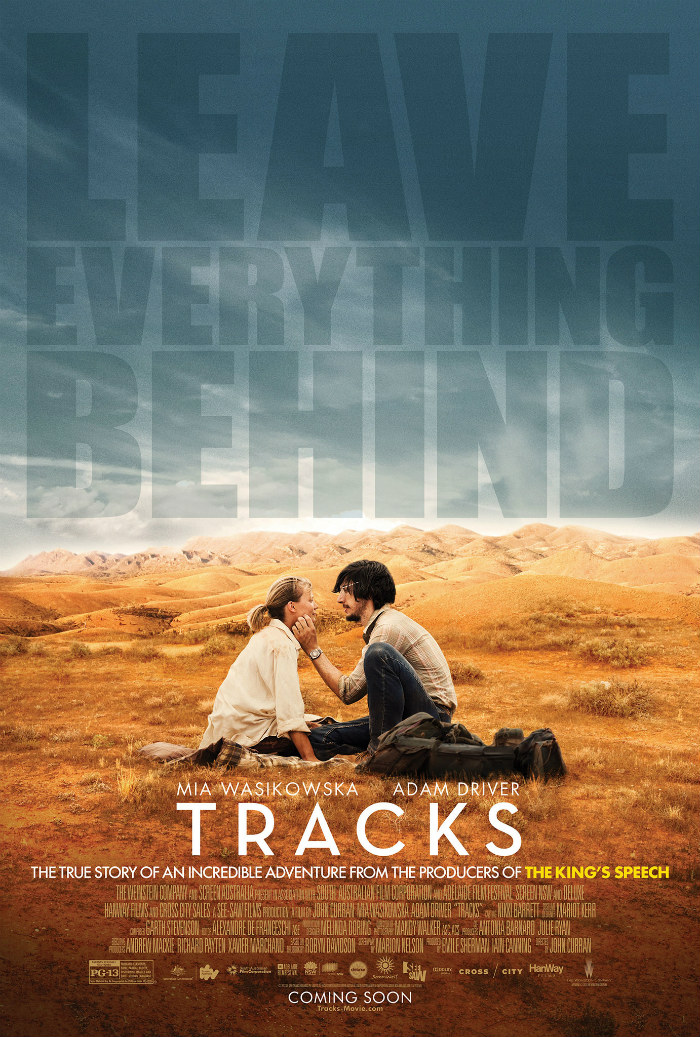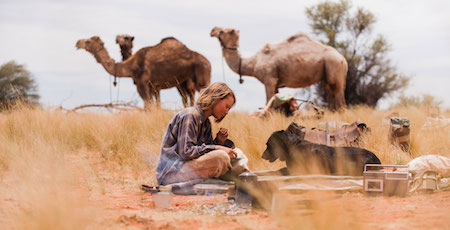Michael Cusumano here to talk about a quality title before the similar Wild completely overshadows it.
 When people ask Robyn Davidson why she intends to trek across 1700 miles of punishing Australian desert with only four camels and her dog as company, she dodges the question or falls back on clichés like “Why not?” But even if Davidson is reluctant to spell out her motivation, director John Curran manages to make Robyn’s actions clear by tuning in the camera to her state of mind. In Tracks, the true story of Davidson’ 1977 journey, people are most often framed as mindless, swarming groups which descend on her, shattering her solitude. Journalists, tourists, even friends and family. They are all mobs. The sound design makes little attempt to separate their dialogue into discernable lines, letting them blend into a pack of chattering hyenas.
When people ask Robyn Davidson why she intends to trek across 1700 miles of punishing Australian desert with only four camels and her dog as company, she dodges the question or falls back on clichés like “Why not?” But even if Davidson is reluctant to spell out her motivation, director John Curran manages to make Robyn’s actions clear by tuning in the camera to her state of mind. In Tracks, the true story of Davidson’ 1977 journey, people are most often framed as mindless, swarming groups which descend on her, shattering her solitude. Journalists, tourists, even friends and family. They are all mobs. The sound design makes little attempt to separate their dialogue into discernable lines, letting them blend into a pack of chattering hyenas.
Having effectively put the audience on Robyn’s wavelength having her explain herself in words would be redundant. We too are ready to spend some time limited to the company of camels.
The obvious comparison for Tracks is to Into the Wild, the major difference being that where Into the Wild showed Christopher McCandless to be blithely overconfident, even reckless, in the face of nature, Tracks shows Robyn as clear-eyed about the dangers of her expedition. She has done the calculation and simply decided that, for her, it is worth the risk. [more...]

Person after person tells her that the plan is suicide, and Davidson takes in this information and presses on undeterred. Tracks is perceptive to the not-so-subtle sexism on display as a procession of rugged Outback men size up the petite and pretty Davidson before declaring her plan insane. (“You must be mad, girlie.”)
 Even if the viewer has never heard of Davidson or the National Geographic coverage that made her world famous as “The Camel Lady” I doubt anyone will get too worked up with suspense over the question of Davidson’s survival. The film doesn’t skimp on depicting the various threats she encounters, but Curran, and the stunning cinematography by Mandy Walker, pushes these moments more for their visual poetry than for thrills. Scenes like a snake slithering across the neck of Robyn’s sleeping body or a tense sequence where she faces certain death after becoming separated from her camels are absorbing, but unlike Into the Wild, or a more extreme cinematic cousin like 127 Hours, Curran’s film isn’t about pumping up the danger, so much as it’s about leading the audience step by step into a certain headspace. It’s chief concern isn’t external threats so much as how Davidson’s will grapple with her internal landscape once she succeeds in emptying her life of human contact.
Even if the viewer has never heard of Davidson or the National Geographic coverage that made her world famous as “The Camel Lady” I doubt anyone will get too worked up with suspense over the question of Davidson’s survival. The film doesn’t skimp on depicting the various threats she encounters, but Curran, and the stunning cinematography by Mandy Walker, pushes these moments more for their visual poetry than for thrills. Scenes like a snake slithering across the neck of Robyn’s sleeping body or a tense sequence where she faces certain death after becoming separated from her camels are absorbing, but unlike Into the Wild, or a more extreme cinematic cousin like 127 Hours, Curran’s film isn’t about pumping up the danger, so much as it’s about leading the audience step by step into a certain headspace. It’s chief concern isn’t external threats so much as how Davidson’s will grapple with her internal landscape once she succeeds in emptying her life of human contact.
Most every story of loners disappearing into nature pushes their protagonists toward the same epiphany: the idea put succinctly into words by Into the Wild’s McCandless as, “Happiness is only real when shared.” Tracks nudges Robyn in a similar direction, but gently, respectfully, and without judgment. She has to deal with an overbearing National Geographic photographer (well played by the ubiquitous Adam Driver) as the cost of financing her trip, and at first he seems like an easy symbol for everything she is running away from. Gradually, though, he is allowed to transcend her initial caricature of him and and emerge from the crowd as a character with dimensions. Brief flashbacks give us a clue as to the childhood pain that would lead a Robyn to flee civilization, but the film wisely avoids trying to explain away her actions with a simple cause and effect rationale. Rather it is layered in as one more shade to this complex woman.
Credit to Mia Wasikowska’s performance as Davidson. Between this work and her scene stealing earlier this year in Only Lovers Left Alive I find myself becoming a fan of an actress who has previously left me cold. She does the real Robyn Davidson proud in her refusal to pander for affection, earning our respect much as the character does, through tenacity and a direct, no frills honesty.
A film like Tracks isn't one that will be having you grabbing your friends by the forearm and insisting they run down to the arthouse. It’s tough to wedge Curran’s movie into a rating at all since so much of the film depends on the viewer’s willingness to set aside the usual narrative beats and ride the film’s meditative currents. There is an absence of urgency to the story by design. After all, there is no real, pressing reason she has to go on this adventure. Your ability to understand why she goes anyway is a good indication of whether this movie is for you.
 Mia Wasikowska as Robyn Davidson in Tracks
Mia Wasikowska as Robyn Davidson in Tracks Robyn Davidson in 1977. Photographed by Rick Smolan
Robyn Davidson in 1977. Photographed by Rick Smolan
Grade: B
Where to see it: Tracks is now playing in New York and LA